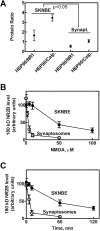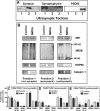Physiological Roles of Calpain 1 Associated to Multiprotein NMDA Receptor Complex
- PMID: 26431040
- PMCID: PMC4592069
- DOI: 10.1371/journal.pone.0139750
Physiological Roles of Calpain 1 Associated to Multiprotein NMDA Receptor Complex
Abstract
We have recently demonstrated that in resting conditions calpain 1, but not calpain 2, is specifically associated to the N-Methyl-D-Aspartate receptor (NMDAR) multiprotein complex. We are here reporting that in SKNBE neuroblastoma cells or in freshly isolated nerve terminals from adult rat hippocampus, the proteolytic activity of calpain 1 resident at the NMDAR is very low under basal conditions and greatly increases following NMDAR stimulation. Since the protease resides at the NMDAR in saturating amounts, variations in Ca2+ influx promote an increase in calpain 1 activity without affecting the amount of the protease originally associated to NMDAR. In all the conditions examined, resident calpain 1 specifically cleaves NR2B at the C-terminal region, leading to its internalization together with NR1 subunit. While in basal conditions intracellular membranes include small amounts of NMDAR containing the calpain-digested NR2B, upon NMDAR stimulation nearly all the receptor molecules are internalized. We here propose that resident calpain 1 is involved in NMDAR turnover, and following an increase in Ca2+ influx, the activated protease, by promoting the removal of NMDAR from the plasma membranes, can decrease Ca2+ entrance through this channel. Due to the absence of calpastatin in such cluster, the activity of resident calpain 1 may be under the control of HSP90, whose levels are directly related to the activation of this protease. Observations of different HSP90/calpain 1 ratios in different ultrasynaptic compartments support this conclusion.
Conflict of interest statement
Figures








Similar articles
-
Interaction between calpain-1 and HSP90: new insights into the regulation of localization and activity of the protease.PLoS One. 2015 Jan 9;10(1):e0116738. doi: 10.1371/journal.pone.0116738. eCollection 2015. PLoS One. 2015. PMID: 25575026 Free PMC article.
-
Calpain regulation of AMPA receptor channels in cortical pyramidal neurons.J Physiol. 2007 Apr 1;580(Pt 1):241-54. doi: 10.1113/jphysiol.2006.122754. Epub 2007 Jan 18. J Physiol. 2007. PMID: 17234699 Free PMC article.
-
Calpain-mediated activation of NO synthase in human neuroblastoma SK-N-BE cells.J Neurochem. 2009 Jul;110(1):412-21. doi: 10.1111/j.1471-4159.2009.06149.x. Epub 2009 May 5. J Neurochem. 2009. PMID: 19457105
-
Role of the NR2A/2B subunits of the N-methyl-D-aspartate receptor in glutamate-induced glutamic acid decarboxylase alteration in cortical GABAergic neurons in vitro.Neuroscience. 2010 Dec 29;171(4):1075-90. doi: 10.1016/j.neuroscience.2010.09.050. Epub 2010 Oct 20. Neuroscience. 2010. PMID: 20923697
-
Preferential inhibition by antidiarrheic 2-methoxy-4-methylphenol of Ca(2+) influx across acquired N-methyl-D-aspartate receptor channels composed of NR1/NR2B subunit assembly.J Neurosci Res. 2010 Aug 15;88(11):2483-93. doi: 10.1002/jnr.22399. J Neurosci Res. 2010. PMID: 20623618
Cited by
-
Cocaine-Induced Synaptic Redistribution of NMDARs in Striatal Neurons Alters NMDAR-Dependent Signal Transduction.Front Neurosci. 2020 Jul 14;14:698. doi: 10.3389/fnins.2020.00698. eCollection 2020. Front Neurosci. 2020. PMID: 32760242 Free PMC article.
-
Pin1 Promotes Regulated Necrosis Induced by Glutamate in Rat Retinal Neurons via CAST/Calpain2 Pathway.Front Cell Neurosci. 2018 Jan 22;11:425. doi: 10.3389/fncel.2017.00425. eCollection 2017. Front Cell Neurosci. 2018. PMID: 29403356 Free PMC article.
-
Temperature-Dependent Olive Pomace Extraction for Obtaining Bioactive Compounds Preventing the Death of Murine Cortical Neurons.Int J Mol Sci. 2024 Jan 11;25(2):907. doi: 10.3390/ijms25020907. Int J Mol Sci. 2024. PMID: 38255981 Free PMC article.
-
A Novel CAPN1 Mutation Causes a Pure Hereditary Spastic Paraplegia in an Italian Family.Front Neurol. 2019 Jun 5;10:580. doi: 10.3389/fneur.2019.00580. eCollection 2019. Front Neurol. 2019. PMID: 31231303 Free PMC article.
-
Proteomic analysis of Nrk gene-disrupted placental tissue cells explains physiological significance of NRK.BMC Res Notes. 2019 Nov 29;12(1):785. doi: 10.1186/s13104-019-4818-7. BMC Res Notes. 2019. PMID: 31783915 Free PMC article.
References
Publication types
MeSH terms
Substances
LinkOut - more resources
Full Text Sources
Other Literature Sources
Research Materials
Miscellaneous

